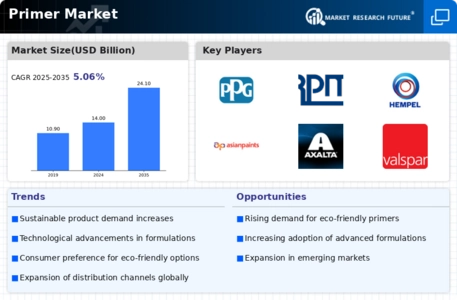Top Industry Leaders in the Primer Market

The primer market, where blank surfaces bloom with possibility, is a bustling battlefield where diverse players vie for control. From established chemical giants to innovative startups, each contender employs unique strategies to cater to a varied audience, from professional painters to DIY enthusiasts. Let's delve into the intricate layers of this market, exploring the strategies, factors impacting market share, recent developments, and its overall landscape.
Strategies Adopted: Priming for Success:
-
Innovation Alchemists: Industry giants like Sherwin-Williams and PPG Industries invest heavily in R&D, developing primers with enhanced features like stain blocking, adhesion-boosting, and eco-friendly formulas. Think primers targeting specific substrates like wood or plastics, options for extreme environments, and water-based formulations for reduced VOC emissions. -
Cost-Conscious Champions: Regional players like Jotun and Nippon Paint focus on affordability, utilizing efficient production processes and readily available raw materials to cater to price-sensitive segments and emerging markets. This strategy ensures their primers reach a wider audience. -
Niche Specialists: Smaller players carve out their niches by specializing in specific applications or technologies. Some focus on primers for historical restoration projects, while others cater to the growing demand for DIY-friendly, user-quick primers. This targeted approach allows them to excel in specialized areas.
Factors Fueling the Market Growth:
-
Construction Boom: The global construction boom, with its surge in residential and commercial building projects, fuels the demand for primers as essential paint preparation tools. -
DIY Revolution: Rising interest in home improvement and DIY projects drives the demand for user-friendly and readily available primers for various surfaces and applications. -
Sustainability Push: Consumer and regulatory pressure towards eco-friendly solutions is prompting the development and adoption of low-VOC, bio-based, and water-based primers. -
Performance Prowess: Advancements in primer technology lead to innovative features like self-priming paints, mold-resistant formulas, and primers that provide extended paint durability, expanding market potential.
Key Players:
-
BASF SE (Germany)
-
Tikkurila OYJ (Finland)
-
PPG Industries Inc. (US)
-
RPM International Inc. (US)
-
Berger Paints India Limited (India)
-
Hempel A/S (Denmark)
-
Asian Paints (India)
-
Nippon Paint Holdings Co., Ltd (Japan)
-
AXALTA (US)
-
Valspar (US)
-
Kansai Paint Co. Ltd (Japan)
-
Akzo Nobel NV (Netherlands)
-
The Sherwin-Williams Company (US)
-
Jotun (Norway)
-
Masco Corporation (US)
Recent Developments:
October 2023: Sherwin-Williams introduces a self-priming paint line that eliminates the need for a separate primer coat, potentially disrupting the market with a streamlined application process.
November 2023: PPG Industries unveils a primer formula specifically designed for historical restoration projects, catering to the niche market of preserving old buildings and artwork.
December 2023: Jotun expands its distribution network in Southeast Asia, aiming to capitalize on the region's booming construction industry and growing demand for affordable primers.
January 2024: Nippon Paint collaborates with a startup to develop a primer made from recycled plastic waste, offering a sustainable solution and addressing concerns about plastic pollution.









